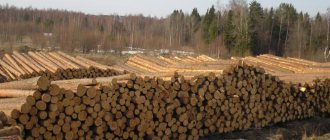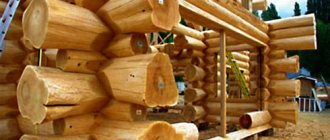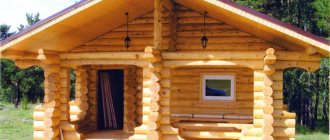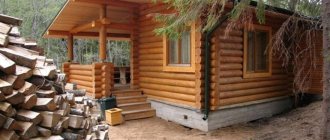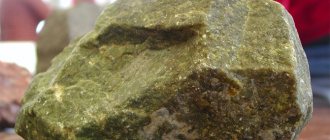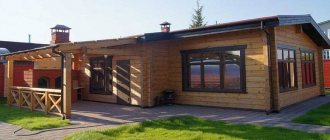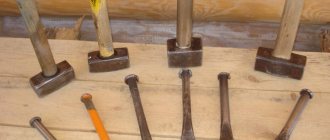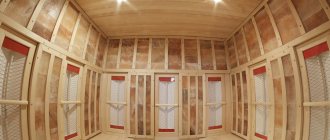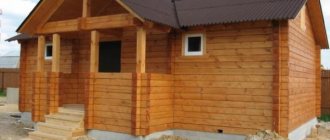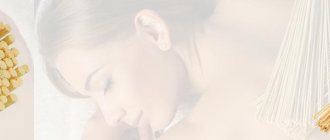Positive properties of aspen
However, it's not all bad. Aspen also has positive qualities, thanks to which it can be used in construction. The first positive property of aspen is good strength. If the wood is well dried, then in this very important indicator it can even be compared with concrete. And over time, the aspen building only gets stronger, becoming heavier. Another equally important positive property of aspen is moisture resistance and, accordingly, resistance to rotting. If the tree itself grows in a humid environment and inevitably rots during its growth, then its wood can withstand the negative effects of moisture for quite a long time. If dried aspen boards accidentally fall into a humid environment, they may temporarily lose their properties. But then, when they become dry again, all the lost properties will be restored. Another positive property of aspen is its ability to emit a pleasant aroma. It is less tart than the smell of coniferous trees, and does not intensify when the air in the room is heated. Therefore, bathhouses are often built from aspen, and the walls of the steam room are lined with aspen boards. And finally, one cannot help but mention the low price of aspen lumber. True, there is also more expensive aspen, which belongs to a high class, and not everyone can afford it.
Aspen
- home
- Wood species
- Aspen
Aspen wood has been used for interior decoration of baths and saunas for a long time. The easily processed material is used for lining, shelf boards, and steam room floors. Manufactured using technology, they are particularly durable, becoming only stronger after moistening and subsequent drying.
Features of aspen wood
Aspen grows throughout Russia, Europe, and Asia. She belongs to the Poplar genus. Therefore, the dense structure of this type of wood is quite soft, and in its strength qualities it is close to linden. This fast-growing plant is suitable for all types of construction work. Its maturation is completed by 40–50 years; trees of this age are harvested for lumber. The fact is that the weak core of aspen often rots from the inside as it ages.
Important properties of aspen wood for finishing baths and saunas:
- Processing the material with hand or mechanical tools is not difficult. It can be polished, ground down, secured with nails or screws in the same amount of time as lime wood. It does not break or warp.
- Low thermal conductivity - lining and boards made of aspen do not burn even in high heat, keeping cool air in the internal voids. Shelves, ladders, benches do not heat up even at high temperatures.
- Resistance to changes in temperature and humidity. The dried wood of this tree can be saturated with moisture by 185%. It quickly releases excess water when the room is ventilated, without succumbing to deformation after drying. The homogeneous structure prevents cracking.
- The rot resistance of aspen lumber is based on the exceptional chemical composition of its fibers. Substances that kill bacteria and mold protect the interior of bathhouses from destruction and prevent unpleasant odors from arising in the steam room and washing department.
Advantages of aspen wood
The decorative qualities of aspen finishing are worth considering separately. A fresh cut surprises with its whiteness, sometimes accompanied by a greenish tint. Numerous bath procedures that wet the surface of the wood give it a noble silvery glow.
The pleasant bitter smell of aspen wood has a positive effect on health. It draws out negative energy, giving a relaxed calm. The evaporated essential substances serve to prevent pulmonary diseases and help with joint pain. The beneficial properties of aspen wood are fully revealed in the hot and humid atmosphere of a Russian bath. Finnish sauna lovers will not notice much difference between aspen and linden lining.
The complex selection of healthy trees for production increases the cost of finished lumber. The savings are especially noticeable when using grade A instead of Extra. Almost no different in physical characteristics, A-class may include a small number of knots. But the practicality and availability of aspen wood makes it a popular material for finishing the interior of a bathhouse.
Aspen lining
Thermal aspen lining
Aspen shelf board
Heat-treated wood shelves
Negative properties of aspen
Often professionals even refuse to work if they know that they will have to deal with aspen. After all, many properties of wood of this species are negative.
First of all, it is worth mentioning such a negative property as the excessive amount of moisture contained in the structure. The core of the aspen trunk, as a rule, rots because of this. Moreover, the process of decay occurs even before the tree is cut down. But this is just the beginning of all the problems. When delving deeper into the processing process, it turns out that only the top of the tree trunk is suitable for this. It can reach a length of four meters. The same moisture contained in the structure makes aspen wood dry. As a result, one edged board has a very large weight.
In any case, if a person chooses aspen wood for building his house or for renovation work, then more than half of the purchased boards will simply have to be thrown away, since they will be completely unsuitable for work.
Many of them will be crooked. And only a small percentage of aspen boards can be subjected to further processing. ← Aspen broom for a bath Building wood: varieties of species →
What are the benefits of aspen? The experience of ancestors and modernity
It has already been said that aspen is a “trembling tree”.
And it also has an amazing ability to emit silvery light... That’s why for the ploughshare (figured carved planks covering the roofs of wooden churches) the masters of the North (and not only) used aspen, and not just any kind, but cut down in the spring and “dried” 2 - 3 months.
By the way, it is also believed that aspen is a tree that absorbs energy, so that a sore spot can be pressed against its trunk for medicinal purposes. And the “aspen” bathhouse is also good: while you are steaming, the aspen seems to repel all illnesses.
In addition, the reduced density of wood (and therefore resistance to heat) and the absence of resin emissions (that is, eliminating the danger of burns) are very valuable qualities of its “bath” use. And, most wonderfully, this light and clean, moisture-resistant rock, which does not warp or crack, only becomes stronger when aged.
Aspen burns well (only if you let it dry for a couple of months), so it is excellent for preparing firewood, which also cleans the chimney of soot (when aspen burns, it burns the soot that remains in the stove from logs of other species). In addition, it “does not mind” and “does not resist”, but on the contrary, it is easy to machine and grind, for which it is valued, for example, by wood carvers and manufacturers of cuttings for household tools.
Matches are made from it (in Russia, every day several dozen carloads of aspen go to match production and approximately the same amount is burned by the population in one day).
From the finest aspen shavings you can weave, like straw , to make artificial flowers. From thick shingles - make shells for sieves, sieves and beakers.
Aspen is suitable for well logs because... not afraid of water. For the same reason, light one-tree boats, called aspen boats, are made from it: they hollow out the middle of the log, fill it with water and steam it by throwing hot stones into the water, and then spread the flexible sides using spacers.
It grows quickly and is therefore used for landscaping. It is used in the leather industry (bark - for tanning leather), in dyeing - to obtain yellow and green colors. Bees do not disdain aspen, collecting pollen from the flowers - catkins, which appear even before the leaves bloom (in April - May), for honey, and from the buds - glue, which is then processed into propolis.
In former times, small ridges were sawed off from fallen aspen trees, the middle of which had turned into dust, the bark was removed from them, and this very dust was cleaned out with a stick cut at the end in the form of a spatula. From the resulting wooden cylinders, village craftsmen made kitchen utensils, nesting hives, birdhouses and kubels (a kind of suitcases for storing and carrying clothes and linen). By the way, today you can use the same method to make... not a suitcase, of course, but, for example, an original flower pot or a floor vase.
Aspen is often criticized by timber industry for its fragility on the root due to its tendency to rot (for this it even received the nickname “forest weed”). It's funny that when this process begins, the tart smell of freshly cut wood changes... to vanilla. Therefore, artificial vanillin is produced from it at chemical industry enterprises.
for medicinal purposes . Preparations from this medicinal raw material have antimicrobial, anti-inflammatory, antitussive and anthelmintic effects. They are used in the treatment of tuberculosis, smallpox, malaria, syphilis, dysentery, pneumonia, coughs of various origins, diarrhea, rheumatism, cystitis: externally - for the treatment of wounds, ulcers and burns, inflammatory processes on the skin and mucous membranes.
This is a modern approach, and people have long had medicinal and healer’s recipes. For example:
1. Fever and teeth can be charmed into aspen. This merciless method involved rubbing the gums with a triangle cut from the bark of a living tree (“In the name of the Father, Son and Holy Spirit”) until the blood bleeds, and then returning this triangle to its original place). 2. If someone has cramps in their legs, then for healing they need to put an aspen log in their legs, and if they have a headache, keep it in their heads.
And in folk home economics, aspen logs cannot be avoided either. It was believed that to prevent the cabbage from becoming sour, you need to put an aspen log in it (and in an aspen bowl, cabbage soup supposedly would not go sour).
That's how she is, aspen!
Tags: aspen, boat, well, matches, trees, bathhouse
Features of larch
Larch wood has a number of unique properties. The most important thing is its durability. So, there are structures that were erected from this material in antiquity and they retained their original appearance for centuries. Houses and wood building materials made from larch withstand any negative environmental influences well.
It should be noted that logs made from this natural raw material have incredible strength and fire resistance. The owner of a larch log house can be confident in the reliability of the walls of his structure. It is worth noting that wood material can create a favorable and healthy atmosphere in the room. Thus, the tree has a unique property: it secretes active substances that suppress the spread of bacteria and help improve immunity.
Due to its durability, reliability, and healing properties, larch is widely used by people in various industries.
Where is larch used?
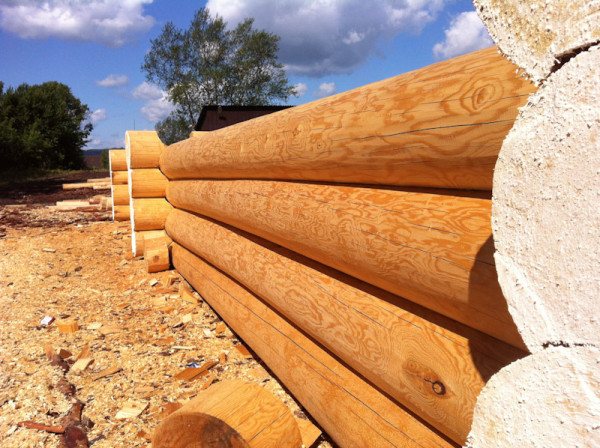
Larch is widely used in various industries and fields of activity. The main ones include:
- construction of houses and cottages, construction of baths and saunas;
- interior and exterior decoration;
- marine shipbuilding;
- pulp and paper production and others.
Of course, in construction, larch materials are among the most popular and are among the most in demand. This is explained by the fact that in terms of density and hardness, this raw material is not inferior to oak and ash. Cottages, country houses, baths, saunas - all of this is built from larch, since structures made from this natural material can last a long time.
Wood is widely used for exterior decoration of buildings and interior decoration. This wood panel can protect any structure from the negative effects of the environment. Wood can add a special flavor to any building or room. This material is often used to make furniture, benches, stairs, and decorate open terraces and verandas.
The gum contained in larch provides it with complete protection from moisture. Also, due to its strength, wood is not subject to various mechanical influences. That is why sea ships are built from this wood material.
The production of sanitary and hygienic products cannot do without cellulose, which is made from Siberian larch. Larch cellulose is also used in the production of banknotes, due to the fact that it is very durable.
